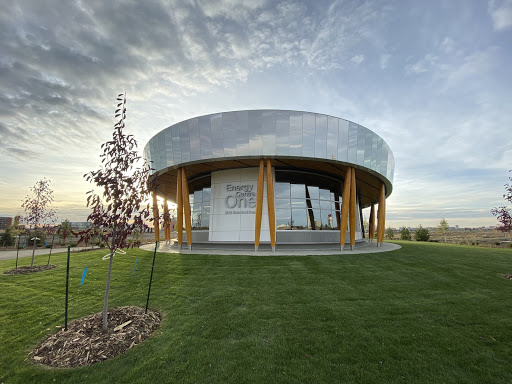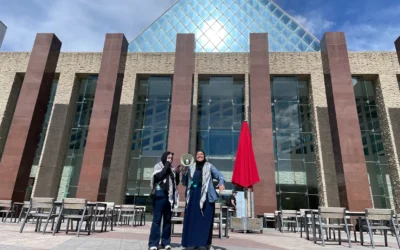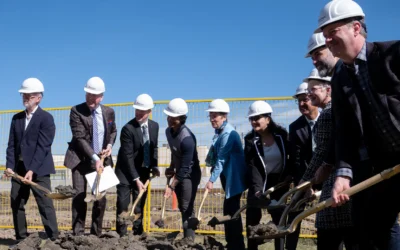Blatchford is a new community being built on 536 acres of land in the heart of Edmonton, where the City Centre Airport used to sit. This will be a neighbourhood different from any other in Edmonton, as the aim is for it to be entirely environmentally friendly.
The construction of the community will take place over the next 25 years. Starting currently, the project is in its first phase. Stage one construction including building the underground infrastructure and roads started a few years ago and consists of bringing in the first home builders to construct townhouses and apartments. Occupancy is set to start sometime this spring. When all the construction is finished, there will be an estimated 30,000 residents living within the community. At the end of March 2019, they began selling these homes.
“The first stage in Blatchford is for the pioneers. It’s for residents that share Blatchford’s exciting vision and can’t wait to be the first to live this kind of urban lifestyle in Edmonton,” says Lauren Bridges, the senior marketing strategist from the Blatchford Redevelopment Office.
“The vision for this community was always around sustainability. Everything should be powered by renewable energy and should be a carbon-neutral community,” said Christian Felske, director of renewable energy systems for the City of Edmonton.
To achieve the goal of being carbon-neutral and sustainable, Blatchford uses a District Energy Sharing System (DESS). This is a centralized system that provides energy for heating, air conditioning, and hot water. How it works is the energy is distributed throughout the community instead of having each singular home being heated. This system increases the efficiency of the energy used and limits wasted energy as all the buildings share the same heating and cooling system.
The main energy source for the community is geothermal — chosen for its reliability as it’s there 24/7, 365 days a year, as opposed to solar or wind energy which is limited to certain weather conditions. Construction for the geo-exchange field began in 2018 with 570 boreholes under what will become the future stormwater pond. These fields are systems to utilize geothermal energy as both a heat source and a heat sink. Blatchford’s geo-exchange field makes it one of the largest geo-exchange fields in Canada. Although geothermal energy isn’t entirely new in Edmonton, on this scale it is.
Mariann Roberts, the lead storyteller from Ocheller by RedBrick, one of the home building companies in Blatchford, explains, “The District Energy Sharing System is a geothermal loop that sends lines deep into the ground to use the earth’s heat to warm a liquid. That liquid is then transferred into every building and used to warm water in a coil inside the furnace, then the heat coming off of that coil is what is used to heat the home. The sharing part of the system is that when some of the buildings are in a cooling stage, the heat that is being lost there is transferred to the buildings that need heat, and vice versa.”
Felske explains that although innovative on this scale, the foundation is already there for such a system. “We’re not the first ones to do it. This is not an experiment. This is to implement it and to showcase it,” he says.
Even in Edmonton, the University of Alberta operates a DESS on its campuses. Other Canadian cities such as Toronto, Ont. as well as Richmond, Langford, Surrey, Vancouver, and Whistler, B.C. use them. In Europe, cities like Copenhagen also use DESS.
At the centre of this system is Energy Centre One, a utility building that stores mechanical equipment in the middle of Civic Plaza right at the heart of the neighbourhood. To offset the electricity needs of the DESS equipment, solar panel arrays will also be used in the future.
“Our intention is not to leave [The DESS] in Blatchford from the utility aspect but also being able to grow from here. There’s an ability to connect other buildings and provide the same amount of energy in a sustainable way,” explains Felske.
The main question from prospective home-buyers is how this differs where consumers are concerned with regular energy utilities. The answer is not much. Edmonton’s city council put in place a kind of municipal utility owned and operated by the City for Blatchford. Residents merely set up an account with the Blatchford Renewable Energy Utility and pay a monthly bill, same as other homeowners in Edmonton. The costs will be about the same, too. City council has made it clear that those living in Blatchford shouldn’t pay more than in other neighbourhoods. This adds a challenge as renewable resources tend to be more expensive than traditional fossil fuel-based energy sources.
“Our ability to be energy resilient or climate-resilient, this should be a showcase. It’s not foremost there to make money. It takes a bit of a burden for the council to invest in this community. But it’s also a leadership project for them. The City has a very ambitious municipal climate change agenda,” says Felske. “This development might serve as an example of how it can be done.”
Although the project is looking to the future of Edmonton, its creators haven’t forgotten where they are located. The Gateway to the North was and is the unofficial name of the first licensed airstrip in Canada, built-in 1927, also known as the City Centre Airport.

Less than a century later, in 2008, the Edmonton city council started discussing the closure of this airstrip. This caused much debate as it was a highlight of Edmonton and an important aspect of Canadian history. A year later, the city council decided to close it down and redevelop the land into something entirely new. On Nov. 30, 2013, The Gateway to the North officially closed with the final plane leaving the airfield that day.
After a lot of debate about what to do with the land, in 2014 Edmonton city council approved the development plans for the Blatchford community, named for the former Mayor that was responsible for the creation of the original airport. Not to miss much time, construction started later that year.
“It’s a great opportunity to be involved in something like this. You say ‘once in a lifetime,’ and it’s true” says Tom Lumsden, Blatchford’s development manager. He admits that in previous developments in Edmonton that he’s worked on, this amount of land can usually only be found in the suburbs, not in the heart of Edmonton, making Blatchford unique.
Currently, this area is zoned as Blatchford Low to Medium Rise Residential Zone (BLMR) and Blatchford Row Housing Zone (BRH) a complete change from its previous zoning as Municipal Airport Airfield Zone (MA1).
Zoning tells you the type of development allowed on a property. As the site transitions from a former airport to a community, it is rezoned to allow for different uses on the land (residential, park, etc),” continues Bridges, “In order to achieve the community’s vision, the Blatchford office developed its own custom zones to achieve certain outcomes related to the community’s design. These items play an important role in how the community functions and feels to residents, businesses and visitors.”

The construction projects themselves also pay tribute to the area’s history. The main street in the community follows the original runway alignments and features an art installation in the centre of a traffic circle as a heritage feature. Inspired by an airplane taking off, the installation is used to invoke what was on the land beforehand. Beyond that, the streets are named after prominent figures of the airstrip.
Lumsden emphasizes the importance of these aspects, “to remind people of what was here.”
With past and future combined into one, it provides a showcase for what can be done elsewhere. The impact on Edmonton’s environmental footprint is set to be a positive one, especially in Alberta where oil and gas is a major industry.
“The importance of sustainable projects such as Blatchford is that it opens up the conversation for what it means to live a sustainable lifestyle, and it demonstrates the additional benefits of living sustainably. It also provides opportunities for people to work, live and play in a way that provides them with an overall better quality lifestyle,” says Roberts.





0 Comments